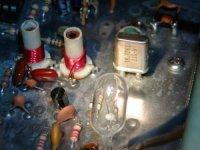|
||||||||
|
Union City, Georgia Spectrum
1000 Power Amplifier Repair |
||||||||
|
This
is the new power amplifier as it was delivered. It came attached to
a heat sink which had to be removed. When installed, the amplifier was
bolted to a larger heatsink fastened to the rear of the exciter chassis.
|
||||||||
|
This
is the repeater sitting out for repair. The large heat sink you see
in the center is the power supply heat sink which was removed later
when a new switching power supply was installed (see pictures below).
The black box on your right is the exciter and the white stuff on the
facing edge is heat sink compound where the larger heat sink for the
Power Amplifier mounts.
|
||||||||
|
Here
the cover has been removed from the exciter compartment and the connections
for the Power Amplifier are hanging ready for attachment. The exciter
board contains all the components to generate the driving signal (about
8 watts). The crystal is in the lower right corner.
|
||||||||
|
The
Power Amplifier board has all of the connections soldered except for
the antenna. You can see the "N" connector in the rear chassis
wall where the board will mount. The connection to the antenna connector
will be made after the physical mounting.
|
||||||||
|
Here
I am soldering the connection to the "N" connector after the
board has been mounted.
|
||||||||
|
That's
about 68 watts output power. Much better than the 250 milliwatts we
had feeding through from the exciter or the 8 watts from the exciter
after removing the dead power amplifier.
|
||||||||
| This view shows the exciter box open with the new PA installed. This picture was taken after the new power supply was installed. | ||||||||
| The crystal oscillator and the light bulb that glows dimly all the time keeping the temperature pretty constant around the oscillator. | ||||||||
| The rear view contrasts with the one above. This one shows the new power supply sitting on top of the exciter. The black box sitting between the receiver and the exciter where the old power transformer and power resistors were houses the relay which switches automatically to battery power when the commercial main disappears. | ||||||||
Latest update to this page was on November 20, 2006








